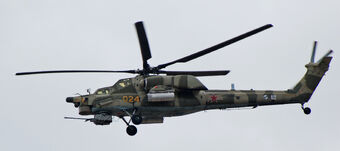The Mil Mi-28 (NATO reporting name "Havoc") is a Russian all-weather, day-night, military tandem, two-seat anti-armor Attack Helicopter. It is a dedicated attack helicopter with no intended secondary transport capability, better optimized than the Mil Mi-24 for the Anti-Tank role. It carries a single gun in an undernose Barbette, plus external loads carried on pylons beneath stub wings.

Mil Mi-28Z in real life
Deployments[]
In 1972, following completion of the Mil Mi-24, development began on a unique attack helicopter with transport capability. The new design had a reduced transport capability (3 troops instead of 8) and omitted the cabin, to provide better overall performance and higher top speed. Improved performance was important for its intended role fighting against tanks and enemy helicopters and covering helicopter landing operations. Initially, many different designs were considered, including an unconventional project with two main rotors, placed with engines on tips of wings (in perpendicular layout), and with an additional pusher propeller on the tail. In 1977, a preliminary design was chosen, in a classic single-rotor layout. It lost its similarity to the Mi-24, and even the canopies were smaller, with flat surfaces.
Design work began on the Mi-28 began under Marat Tishchenko in 1980.[3] In 1981, a design and a mock-up were accepted. The prototype (no. 012) was first flown on 10 November 1982.[3] The second prototype (no. 022) was completed in 1983. In 1984, the Mi-28 completed the first stage of state trials, but in October 1984 the Soviet Air Force chose the more advanced Kamov Ka-50 as the new anti-tank helicopter. The Mi-28 development was continued, but given lower priority. In December 1987 Mi-28 production in Rosvertol in Rostov on Don was approved. In January 1988 the first Mi-28A prototype (no. 032) flew. It was fitted with more powerful engines and an "X" type tail rotor instead of the three-blade version. The Mi-28A debuted at the Paris Air Show in June 1989. In 1991 the second Mi-28A (no. 042) was completed. The Mi-28A program was cancelled in 1993 because it was deemed uncompetitive with the Ka-50, and in particular, it was not all-weather capable.
Changes[]
Changes from Call of Duty Modern Warfare 2 to Call of Duty: Modern Warfare 2: ODST[]
- When destroyed in Call of Duty: Modern Warfare 2: ODST, it explodes into pieces of small wreckage.
- Elites can pilot the vehicle.